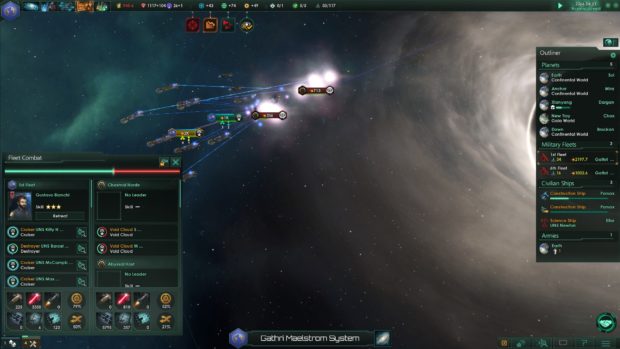The war against the Finu Confederated Provinces was not going well. Their declaration of war against my ally, the Jabbarid Stellar Commonwealth, had taken me off guard. My fleets were dispersed and in dire need of reinforcement. And to make matters worse, a massive enemy fleet was sighted heading for one of the planets deep in my rear, followed by a force of troop transports. The Finu, 38 corvettes and 8 destroyers strong, quickly destroyed the defenses over the planet Bounty, and then commenced pounding the fortifications there into dust. At this moment, my first corvette arrived in the system, alone, to take on the entire enemy force. But as the enemy broke away from their planetary bombardment to take on my lone vessel, my first fleet, followed by a fleet sent by the Jabbarrid, arrived in the system. The battle was on.
Stellaris is the new space 4X game from Paradox Development Studio. PDS is better known for its historical grand strategy epics Europa Universalis, Hearts of Iron and Crusader Kings, so this game is a bit of a break from its wheelhouse. It’s such a departure that I actually approached this game with trepidation. Not to worry, though, for Stellaris showed itself to be not only a highly entertaining effort, but quickly proved itself to be the space game I had always wanted.

A game of Stellaris opens with race selection. There are a number of different options or you can create your own. The differences between the races are more than semantic. Different research trees (though, as I’ll explain later, tree is probably the wrong word), different ships, and even different methods of moving between star systems distinguish each race, providing a unique experience for each playthrough. Then, it is off to play. You’ll open up with an option to turn on the tutorial. The tutorial was a highlight for me, as it allowed me to actually play the campaign and learn at the same time. It’s an excellent guidance system, chiming in at the right moments, and really does an excellent job of explaining the game’s mechanics and systems without boring you with minutiae. After activating the tutorial, I was left with my home planet, a small fleet, one science vessel, and an entire unknown universe.

The exploration is my favorite part of Stellaris. 4X games always begin with exploration, and a good system here will make the game for me personally more than the endgame fight for supremacy. As the game opened, I knew literally nothing about what was going on around me. As I sent out my research vessel to survey the surrounding area, I encountered new worlds and strange alien life forms. As one would expect, a good deal of scientific research was required before I could interact or communicate with these new life forms. Without research, it was impossible to know if I was interacting with docile space cows, mindless amoeba trying to swallow me whole, or an interstellar civilization. I was living in the dark about newly encountered ships or prehistoric civilizations until I had pressed for the necessary knowledge. It felt like such an improvement from the random, “meet one unit, and now get introduced to the entire civilization” system you see in games like Civilization. It felt more true to how I would expect the encounter to go.
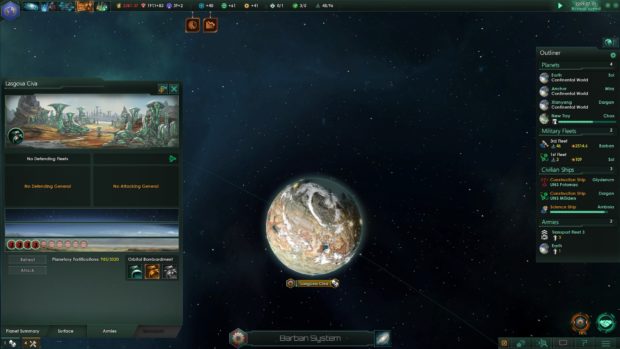
Speaking of research, I was very impressed with the game’s scientific research model. Instead of presenting you with a tree (resulting in a specific pattern for research that is optimal and should be used every time), Stellaris presents you with a random assortment of choices to select from. This means that you have to make tough choices in what to research, as the other options might not be available when you finish your current project. You can also make progress in research by investigating anomalies or the shattered hulks of destroyed enemy ships. I was able to complete my research into very high level torpedos solely by investigating the remains of defeated enemy vessels.
Being a Paradox game, the game has a fully formed diplomacy model. As I expanded my interstellar empire, I was able to establish embassies, form alliances, fight wars, make peace, and ever create an interstellar federation. The war and peace is very similar to the system in Europa Universalis IV, with war goals and ticking scores depending on how well you are doing. There are a number of different avenues to approach in diplomacy, with trade, border access and even immigration being important issues.
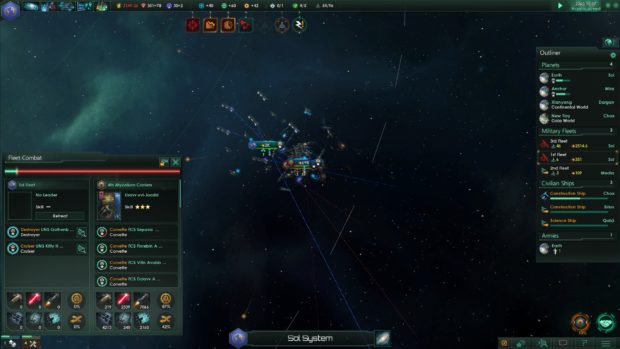
Planetary management is a large part of the game, and I will admit that when I heard the term POP used, I was nervous. I never quite figured out the POP system in PDS’s Victoria 2, but here the system is streamlined, manageable, and fun. Population on planets is represented by POP, which are assigned to work a square on that planet, generating resources. Those squares can be built up with mines, factories and research centers, which can later be upgraded through new technologies. The POPs can emigrate from one world to the next, or be of a different race through conquest, meaning that the longer the game goes on, the more mixed your planets will become. Well, that is unless your race is xenophobic, and would rather purge others to maintain purity. If the planet management gets too much because you have too many planets to manage, you can group your worlds into self-run sectors. Sectors generate income and resources without requiring player management, which allowed me to run a sprawling empire with much less effort. I did have to take care, though, as the populations of sectors can develop their own personalities, and even demand independent.
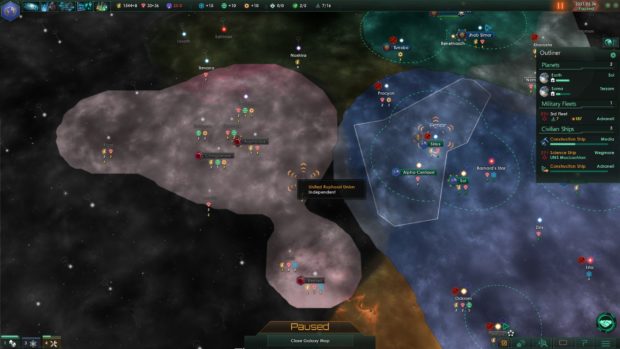
Stellaris also includes a huge number of deeply, well-developed random events. From time to time, I ended up battling an cult across the galaxy because it was trying to overthrow my government, moving a race of gas people from one planet to another even though they couldn’t remember my name, and pissing off a group of ancient mining drones because I was bad at making decisions. These events really flesh out the game, providing both an intriguing narrative element and moments of utter hilarity.
I have to take my hat off to the game’s user interface. I was confused at first at the game’s lack of a mini-map, but the more I played, the more I experienced how easily it was to move from the overmap to the individual star systems. At any time I could right click on the my planets, fleets, and civilian vessels listed on the right side of the screen and instantly be the right system, no loading. I could manage my planets without having to look at them. It was also possible to hot key fleets and planets, though, in the real-time pausable game, it really wasn’t vital. The game also has a very sublime and awesome soundtrack that, if you’ve played Europa Universalis IV, you will recognize a lot of elements of (though it has been, well, space-ified).
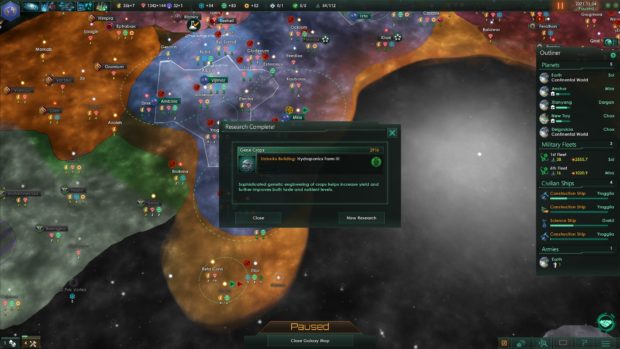
Stellaris is the most fun, addicting 4X game I’ve played in a long, long time. The other night I set myself an alarm so that I would stop playing and go to bed, and I put the alarm across the room so I’d have to get up to turn it off. Well, my lazy ass got up and reset that alarm three times. On the fourth go around, I just shut it off, went back to my computer, and played for another hour. Stellaris takes me back to being a Civ-addicted teenager again, unable to stop myself from playing a game, and loving every minute of it. The game is complex and deeply detailed, but so easy to pick up and play that I can heartily recommend it to anyone.
